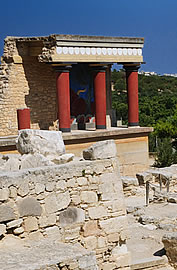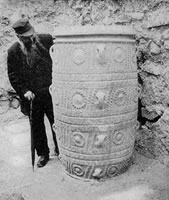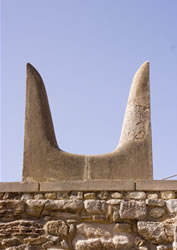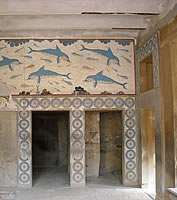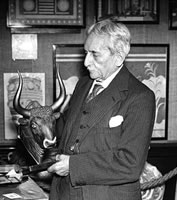




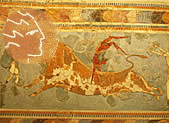
The Palace of Knossos
Situated 5km SE of the city of Heraklion is the most important archaelogical site in Crete - Knossos, the most representative relic of the Minoan civilization which once flourished on the island.
The palace is built on the slopes of Kefalas mountain with easy access to towards the sea and the interior of Crete.According to legend it was the seat of the wise King Minos. Enthralling legends abound in the area of the palace of Knossos relating to:
the labyrinth, the minotaur, Daedalus and Icarus. According to the historical evidence the palace of Knossos was built around 1900 BC on the Kefala heights on top of a Neolithic settlement populated in 6.000BC.
It encompasses an area of 22.000m2 wherein developed the most ancient city of Crete with a population reaching 80.000 people evidenced by the presence of cemeteries nearby. During the copper age there is no other building that surpasses in grandeur and luxury the palace of Knossos. The palace of 22.000m2, boasts 1.500 rooms, five storeys at some points, two extensive cobbled courtyards, theatre, sanctuaries, workshops and storage rooms with exquisite clay gigantic jars (pytharia).The palace was architecturally designed, securing coolness in summer, warmth in winter and light radiating in all the spaces. Water emanated from as far as the areas of Kounavon and Archanon, was transported via clay pipes leading to the aquaduct of the city from where the water was distributed to the houses.
This palace was destroyed around 1700 BC and in its place another one was built. The period from 1700-1450 BC is the most illustrious of the Minoan civilization and in particular Knossos. In 1600 BC the palace was subjected to heavy damages from an earthquake, soon to be repaired, while other new buildings are added. These new buildings together with pre-existing buildings form basically todays archaeological site of Knossos.
The palace was completely destroyed by the Achaen invasion and was never used again. During the Greek period Knossos started developing again and became the centre of attention in Crete. However in the 3rd century it was completely destroyed by neighbouring Gortynia. The name Knosssos is referred to as the cathedral of the bishops seat until the 5th century A.D. Later the bishops seat is transferred from Knossos to the ancient town of Rafko, today’s Agio Myrona and the name is never to be mentioned again. The area was to be renamed “makrytichos”which stands until today, meaning merely long wall, and the grand name of Knossos was no more.
In 1878 excavations are carried out by an Herakliote, Minos Kalokairinos in an effort to bring the findings to the surface. These first trial diggings brought to light a lot of clay gigantic jars (pytharia) and signifiacant artefacts. Soon after, these excavations ceased, for 1900 to come, when the English archaeologist Arthur Evans and his staff begin systematic excavations in the area which last for a full 35years. Evans restored the palace of Knossos and was severely criticized for using in many of the buildings, an overdose of cement. As things turned out later, these buildings would not otherwise have been able to stand the test of time.
Apart from the Minoan palace complex, todays visitor can enjoy the private ancient villas, richly decorated internally with mural paintings, public buildings and religious centres A luxury private villa still survives today, colonnaded externally with magnificent mosaic floor tiles dating from the Roman era.
The numerous artefacts of exquisite art dug out from the palace , like various pots, vessels, utensils, idols, Linear B language tablets and original murals (wall paintings) are all housed in the Heraklion museum.
Knossos informations
Tickets
Full: €6, Reduced: €3
Special ticket package: Full: €10, Reduced: €5
Valid for: Herakleion Archaeological Museum, Knossos
Free admission days
Sundays in the period between 1 November and 31 March The first Sunday of every month, except for July, August and September (when the first Sunday is holiday, then the second is the free admission day.) 27 September, International Tourism Day.
Free admission for:
University students from Greece and the E.U.
Telephone: +30 2810 231940, +30 2810 226470, +30 2810 226092, +30 2810 224630
Fax: +30 2810 241515
Open hours: 14-30 of September 2009 daily until 19.30 1-31 of October 2009 daily until 18.00
Situated 5km SE of the city of Heraklion is the most important archaelogical site in Crete - Knossos, the most representative relic of the Minoan civilization which once flourished on the island.
The palace is built on the slopes of Kefalas mountain with easy access to towards the sea and the interior of Crete.According to legend it was the seat of the wise King Minos. Enthralling legends abound in the area of the palace of Knossos relating to:
the labyrinth, the minotaur, Daedalus and Icarus. According to the historical evidence the palace of Knossos was built around 1900 BC on the Kefala heights on top of a Neolithic settlement populated in 6.000BC.
It encompasses an area of 22.000m2 wherein developed the most ancient city of Crete with a population reaching 80.000 people evidenced by the presence of cemeteries nearby. During the copper age there is no other building that surpasses in grandeur and luxury the palace of Knossos. The palace of 22.000m2, boasts 1.500 rooms, five storeys at some points, two extensive cobbled courtyards, theatre, sanctuaries, workshops and storage rooms with exquisite clay gigantic jars (pytharia).The palace was architecturally designed, securing coolness in summer, warmth in winter and light radiating in all the spaces. Water emanated from as far as the areas of Kounavon and Archanon, was transported via clay pipes leading to the aquaduct of the city from where the water was distributed to the houses.
This palace was destroyed around 1700 BC and in its place another one was built. The period from 1700-1450 BC is the most illustrious of the Minoan civilization and in particular Knossos. In 1600 BC the palace was subjected to heavy damages from an earthquake, soon to be repaired, while other new buildings are added. These new buildings together with pre-existing buildings form basically todays archaeological site of Knossos.
The palace was completely destroyed by the Achaen invasion and was never used again. During the Greek period Knossos started developing again and became the centre of attention in Crete. However in the 3rd century it was completely destroyed by neighbouring Gortynia. The name Knosssos is referred to as the cathedral of the bishops seat until the 5th century A.D. Later the bishops seat is transferred from Knossos to the ancient town of Rafko, today’s Agio Myrona and the name is never to be mentioned again. The area was to be renamed “makrytichos”which stands until today, meaning merely long wall, and the grand name of Knossos was no more.
In 1878 excavations are carried out by an Herakliote, Minos Kalokairinos in an effort to bring the findings to the surface. These first trial diggings brought to light a lot of clay gigantic jars (pytharia) and signifiacant artefacts. Soon after, these excavations ceased, for 1900 to come, when the English archaeologist Arthur Evans and his staff begin systematic excavations in the area which last for a full 35years. Evans restored the palace of Knossos and was severely criticized for using in many of the buildings, an overdose of cement. As things turned out later, these buildings would not otherwise have been able to stand the test of time.
Apart from the Minoan palace complex, todays visitor can enjoy the private ancient villas, richly decorated internally with mural paintings, public buildings and religious centres A luxury private villa still survives today, colonnaded externally with magnificent mosaic floor tiles dating from the Roman era.
The numerous artefacts of exquisite art dug out from the palace , like various pots, vessels, utensils, idols, Linear B language tablets and original murals (wall paintings) are all housed in the Heraklion museum.
Knossos informations
Tickets
Full: €6, Reduced: €3
Special ticket package: Full: €10, Reduced: €5
Valid for: Herakleion Archaeological Museum, Knossos
Free admission days
Sundays in the period between 1 November and 31 March The first Sunday of every month, except for July, August and September (when the first Sunday is holiday, then the second is the free admission day.) 27 September, International Tourism Day.
Free admission for:
University students from Greece and the E.U.
Telephone: +30 2810 231940, +30 2810 226470, +30 2810 226092, +30 2810 224630
Fax: +30 2810 241515
Open hours: 14-30 of September 2009 daily until 19.30 1-31 of October 2009 daily until 18.00
